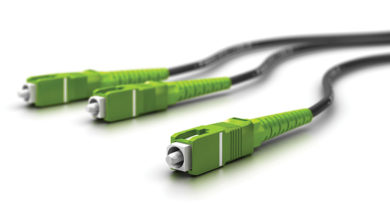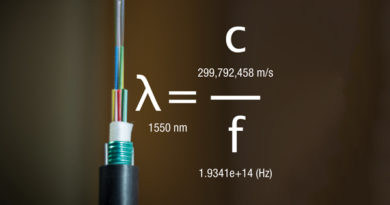Live Long and Multiplex?
By Steven Harris
The Enterprise had to observe the warp speed limit set by the council, however, it seems there are no limits where a multiplexed network can go! The fastest data speed for optical fiber was 43 terabits per second (Tbps), a record set in 2014 by the Technical University of Denmark. However, a new record of 255 Tbps was set the same year, two months later by researchers at the Eindhoven University of Technology in the Netherlands and the University of Central Florida.
These breakthroughs were made possible by engineers like Nobel Prize winner Charles Kuen Kao, the “Father of Fiber Optic Communications,” who recently passed in September. As demonstrated by these universities and the work of Kao, using fiber optics as a transmission medium has the protentional to provide significant innovation for our cable networks. Optics will deliver exciting future experiences and what seems like limitless capability for our customers.
Today, many operators are planning to invest in optical fiber architectures like fiber deep, xPON (e.g., GPON, XGS-PON, EPON), RFoG, R-PHY distributed access architectures (DAA) and R-MAC/PHY DAA. Like RF coaxial networks, today’s optical networks rely on the concept of modulation and multiplexing to provide signaling, but instead of RF they use light through a length of glass (optical fiber) to the customer. The light produced in these networks is often by a laser in the portion of the electromagnetic spectrum from approximately 300 nanometers (nm) to 2000 nm wavelength.
Within the concepts of multiplexing and modulation, multiplexing is often misunderstood in terms of its operational benefits. For our new fiber deep, DAA and xPON architectures, multiplexing over hydroxyl (OH) free silicon fiber is an excellent solution to achieving the “Gigabit Era of Connectivity.” The alternative to multiplexing is very costly, as operators would need to invest in more equipment at the headend, perform significant access network enhancements, and perform construction activities to install additional optical cables. With multiplexing, an operator is able to use their capital expenses (CapEx) more effectively by using the optical cables they have already installed in the network. In addition, optics can help to reduce operational expense (OpEx) for operators.

Truly understanding the concept of multiplexing allows a telecommunication professional to be well prepared to meet the demands of tomorrow’s telecommunication network. Multiplexing involves combining light of different colors (wavelengths) for simultaneous transmission on a single optical fiber. These new additional channels are found within the terahertz (THz) region and are referred to as lambas, after the Greek letter λ.

Multiplexing technology allows an operator to obtain more bandwidth and capacity over a transmission medium such as coaxial or optical fiber without the requirement of adding additional physical layer (PHY) cables. Each λ has its own spectral width (i.e., channel width) and can carry its own transmission format (e.g., analog or digital) and individual data rates. Multiplexing provides scalability for operators by allowing them to purchase and install optical equipment for additional demand as required. For example, today operators may install a 1 Gbps EPON optical distribution network (ODN) and tomorrow may provide a 10 Gbps EPON option using the same optical fiber. Since multiplexing uses many λ of light, routing and switching of λ are also possible. The components of multiplexing start with the λ that are to be combined or multiplexed (i.e., muxed), then transmitted over a single optical fiber to a demultiplexer (i.e., demux) where the λ are separated.
There are many forms of RF and optical multiplexing used in our networks today. The first early forms of multiplexing used “frequency” to create sub communication channels. These were known as frequency division multiplexing (FDM), in which each signal is assigned its own frequency or channel. Later came time division multiplexing (TDM) and time division multiple access (TDMA), which divides a channel into different time slots for transmission of information. TDM allows communication devices to take turns on a medium using time periods. The more advanced TDMA divides a channel at an assigned frequency into different time slots of communication, working with a centralized controller (e.g., CMTS). Synchronous code division multiple access (S-CDMA) was also introduced in cable, using multiple short or long duration symbols to provide better immunity against impulse noise below 20 MHz in the cable plant.
The early days of frequency division multiplexing date back to the “Father of Radio” Guglielmo Marconi’s experiments in the late 1800s and early 1900s, another Nobel Prize winner. As mentioned earlier, FDM transmits at assigned frequencies over a medium using defined channels like today’s CTA-542-D standard, which are often used in the cable downstream. Building on FDM, orthogonal frequency division multiplexing (OFDM) was introduced to support multiple closely spaced modulated carriers or sub channels transmitted over the communication channel simultaneously, improving bandwidth and capacity.

An optical variant of FDM, called wide wavelength division multiplexing (WWDM) by the ITU is a technique in which several different λ are simultaneously transmitted or coupled (e.g., 1310 nm or 1550 nm) over a common medium such as optical fiber. WWDM in a sense creates virtual fibers, each with its own signal assigned and a different λ or “color” of light, typically separated by 50 nm or greater. WWDM is commonly referred to as wavelength division multiplexing (WDM) in the telecommunications industry. Another variant of WDM known as time and wavelength division multiplexing (TWDM) is used in NG-PON2 that leverages TDMA to support 10 Gbps optical network terminals (ONTs) with WDM.
To enhance the number of channels beyond WDM in an optical fiber or “waveguide,” coarse WDM (CWDM) was introduced, increasing data rates on a single fiber optic waveguide. CWDM provides an increased number of spectral width channels (e.g., typically eight up to 18) that are spaced apart less than 50 nm but greater than or equal to 1000 GHz (i.e., 20 nm). CWDM is popular as it offers a lower cost of ownership over dense WDM (DWDM) and operates with uncooled lasers. However, CWDM provides lower data rates than DWDM. CWDM operates between 1271 nm to 1611 nm, or ITU optical channels C1 to C18. CWDM uses wide bandpass filtering to separate a λ from the mux while reflecting other λ that are not desired at a location. Filtering is also used to combine CWDM channels onto a single fiber. If erbium doped fiber amplifiers (EDFAs) are used, only channel C15 or 1551 nm (central λ) may be used, as that is where a 1550 nm EFDAs will operate.

DWDM is a technique in which a large number of different λ (e.g., 32+) are simultaneously transmitted, increasing the data rates over a single piece of optical fiber. There are different types of DWDM channel spacing grids, which is important to understand as channels are aligned by the spacing type used and these are well defined by the ITU. DWDM grid spacing options include 200 GHz (1.6 nm), a modern 100 GHz (.8 nm), another modern 50 GHz (.4 nm), a newer 25 GHz (.2 nm), and the newest option 12.5 GHz (.1 nm). The 100 GHz or .8 nm spacing is a popular option in telecommunications between 1519 nm and 1578 nm, offering 73 DWDM channels.
Most operators have chosen the 100 GHz grid to operate using channels C21 to C60 (40 λ). Even using the 100 GHz grid requires very stable lasers, because inconsistent temperature or aging will impact DWDM performance in the network. By using a different ITU grids and associated optical equipment operators have options ranging from 16 λ up to 320 λ using 12.5 GHz spacing over a single optical waveguide. An important note, as an operator increases the density of wavelengths carried on a single fiber, the cost and power requirements also increase. For example, DWDM lasers are temperature-stabilized with coolers integrated into their module package, which is not required with CWDM and WDM. As operators push the envelope with closer λ spacing it may be more difficult to demux a λ while maintaining acceptable adjacent channel separation. In addition, the total optical power per λ must be controlled, as performance and reach (i.e., distance) may be impacted.

There is no doubt the complexity, capacity and reliability of our optical networks will continue to increase as we innovate and evolve to offer unsurpassed services to our customers. All network telecommunication professionals will operate in multiplexed networks, whether that is RF, Wi-Fi, MoCA, DAA R-PHY, fiber deep, FDX DOCSIS, etc. Engineers will continue to push the terabit limits, new architectures will evolve our access networks, and multiplexing has become a vital component in our communication networks. Be sure to keep ahead of the optical curve with all the benefits of being an SCTE·ISBE member, until next time “Make it So!”
 Steven Harris
Steven Harris
Senior Director, Advanced Network Technology and Instruction, Learning and Development, SCTE•ISBE
Steve Harris is the senior director of advanced network technology and instruction at SCTE•ISBE. He is a respected international telecommunications subject matter expert, sought-after presenter and principal instructor. He is responsible for the tremendous growth of SCTE•ISBE training programs and certifications for over 100,000 telecommunications professionals. He also has responsibility for the client partnership in the SCTE•ISBE Corporate Alliance Program for cable operators and vendors.
Shutterstock



